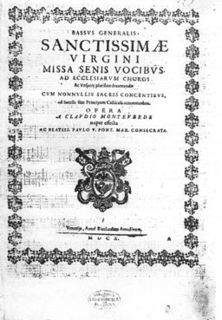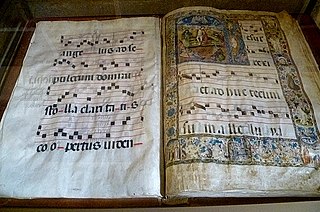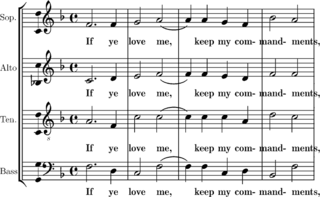
A book is a medium for recording information in the form of writing or images, typically composed of many pages bound together and protected by a cover. The technical term for this physical arrangement is codex. In the history of hand-held physical supports for extended written compositions or records, the codex replaces its immediate predecessor, the scroll. A single sheet in a codex is a leaf, and each side of a leaf is a page.
Sheet music is a handwritten or printed form of musical notation that uses musical symbols to indicate the pitches, rhythms or chords of a song or instrumental musical piece. Like its analogs – printed books or pamphlets in English, Arabic or other languages – the medium of sheet music typically is paper, although the access to musical notation since the 1980s has included the presentation of musical notation on computer screens and the development of scorewriter computer programs that can notate a song or piece electronically, and, in some cases, "play back" the notated music using a synthesizer or virtual instruments.

Print on demand (POD) is a printing technology and business process in which book copies are not printed until the company receives an order, allowing prints of single or small quantities. While other industries established the build to order business model, "print on demand" could only develop after the beginning of digital printing, because it was not economical to print single copies using traditional printing technology such as letterpress and offset printing.

A yearbook, also known as an annual, is a type of a book published annually. One use is to record, highlight, and commemorate the past year of a school. The term also refers to a book of statistics or facts published annually. A yearbook often has an overarching theme that is present throughout the entire book.

Vespro della Beata Vergine, SV 206 is a setting by Claudio Monteverdi of the evening Vespers service on Marian feasts, scored for soloists, choirs, and orchestra. Monteverdi's Vespers is an ambitious work both in scope and in variety of style and scoring, with a duration of around 90 minutes. Published in Venice as Sanctissimae Virgini Missa senis vocibus ac Vesperae pluribus decantandae, cum nonnullis sacris concentibus, ad Sacella sive Principum Cubicula accommodata, it is also called the Vespers of 1610 to distinguish it from other Vespers printed in 1640 and 1651.

Multitrack recording (MTR)—also known as multitracking, double tracking, or tracking—is a method of sound recording developed in 1955 that allows for the separate recording of multiple sound sources or of sound sources recorded at different times to create a cohesive whole. Multitracking became possible in the mid-1950s when the idea of simultaneously recording different audio channels to separate discrete "tracks" on the same reel-to-reel tape was developed. A "track" was simply a different channel recorded to its own discrete area on the tape whereby their relative sequence of recorded events would be preserved, and playback would be simultaneous or synchronized.
Prepress is the term used in the printing and publishing industries for the processes and procedures that occur between the creation of a print layout and the final printing. The prepress procedure includes the manufacture of a printing plate, image carrier or form, ready for mounting on a printing press, as well as the adjustment of images and texts or the creation of a high-quality print file. In today's prepress shop, the form of delivery from the customer is usually electronic, either a PDF or application files created from such programs as Scribus, Adobe InDesign, Adobe illustrator, or QuarkXPress.
The bibliographical definition of an edition includes all copies of a book printed “from substantially the same setting of type,” including all minor typographical variants.
John Sheppard was an English composer of the Renaissance.

A Choirbook is a large format manuscript used by choirs in churches or cathedrals during the Middle Ages and Renaissance. The book is large enough for the entire choir to read from one book. Choirbooks were generally put on a stand with the smaller boy sopranos in front and the men in back. Once the printing of music became easier and more commonplace, choirbooks fell out of favour, replaced by smaller, cheaper, and easier to handle books and octavos.
Nicholas Ludford was an English composer of the Tudor period. He is known for his festal masses, which are preserved in two early-16th-century choirbooks, the Caius Choirbook at Caius College, Cambridge, and the Lambeth Choirbook at Lambeth Palace, London. His surviving antiphons, all incomplete, are copied in the Peterhouse Partbooks. Ludford is well-known as being the composer of the only surviving cycle of Lady Masses, small-scale settings of the Ordinary and Propers in three parts to be sung in the smaller chapels of religious institutions on each day of the week. Ludford's composing career, which appears to have ended in 1535, is seen as bridging the gap between the music of Fayrfax and that of John Taverner (1495–1545). Music scholar David Skinner has called Ludford "one of the last unsung geniuses of Tudor polyphony". In his Oxford History of English Music, John Caldwell observes of Ludford's six-part Mass and Magnificat Benedicta that it "is more a matter of astonishment that such mastery should be displayed by a composer of whom virtually nothing was known until modern times".
The Gyffard Partbooks are an important set of English Renaissance choral partbooks, containing pieces by composers such as Thomas Tallis and John Sheppard, as well as additional unnamed composers, which are not found in other sources.
United States copyright registrations, renewals, and other catalog entries since 1978 are published online at the U.S. Copyright Office website. Entries prior to 1978 are not published in the Online Catalog. Copyright registrations and renewals after 1890 were formerly published in semi-annual softcover catalogs called The Catalog of Copyright Entries or Copyright Catalog or published in microfiche.

The Mass for Four Voices is a choral Mass setting by the English composer William Byrd (c.1540–1623). It was written around 1592-3 during the reign of Queen Elizabeth I, and is one of three settings of the Mass Ordinary which he published in London in the early 1590s.
The Digital Image Archive of Medieval Music (DIAMM) is a non-profit academic service provider. It is the only complete listing of all medieval and early modern manuscripts of European polyphonic music. It is founded on a digital archive of images of European medieval and early modern polyphonic music ranging from complete manuscripts to fragments. The collection, created by the University of Oxford and Royal Holloway University of London, includes metadata for all manuscripts from 800 to 1650 A.D. with images for about 20% of the sources. The image collection is added to on a regular basis thanks to donations from libraries and collaborations with projects who acquire images and are able to donate them to DIAMM for display.

Drexel 4180–4185 is a set of six manuscript partbooks copied in Gloucester, England, containing primarily vocal music dating from approximately 1615-1625. Considered one of the most important sources for seventeenth century English secular song, the repertoire included represents a mixture of sacred and secular music, attesting to the partbooks' use for entertainment and pleasure, rather than for liturgical use.
The Forrest-Heyther partbooks are a set of six manuscript partbooks copied in England in the sixteenth century. They are an important source of polyphonic Mass Ordinary settings by composers from the reign of Henry VIII, including John Taverner and Robert Fayrfax.
The Peterhouse partbooks are a collection of English partbooks dating from the sixteenth and seventeenth centuries. They are named "Peterhouse" after Peterhouse in Cambridge, where the books were kept for some time, and are now preserved in the Cambridge University Library. They are handwritten manuscripts, all written on paper. At some point in the mid-eighteenth century, the books were rebound, although the foliation and indices remained unchanged.

The Oxford Book of Tudor Anthems is a collection of vocal scores of music from the Tudor era of England (c.1550-1625). It was published in 1978 by Oxford University Press and was compiled by the organist and publisher Christopher Morris (1922-2014), the editor of OUP who also launched the popular Carols for Choirs series of books in the 1970s. The preface is written by Sir David Willcocks.

"If Ye Love Me" is a four-part motet or anthem by the English composer Thomas Tallis, a setting of a passage from the Gospel of John. First published in 1565 during the reign of Elizabeth I, it is an example of Tudor music and is part of the repertoire of Anglican church music. An early homophonic motet in English, it is frequently performed today, and has been sung at special occasions including a papal visit and a royal wedding.










